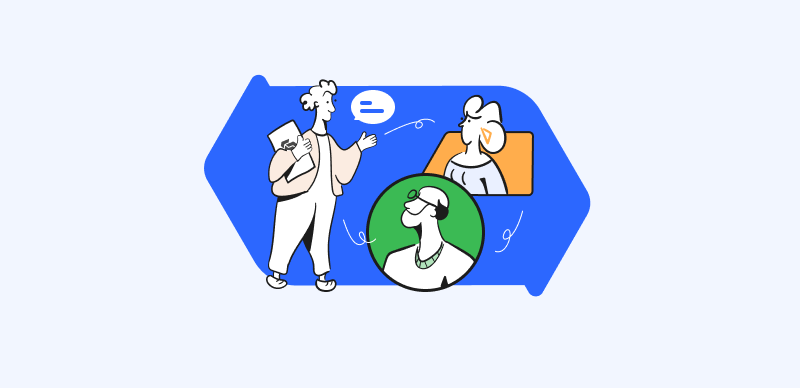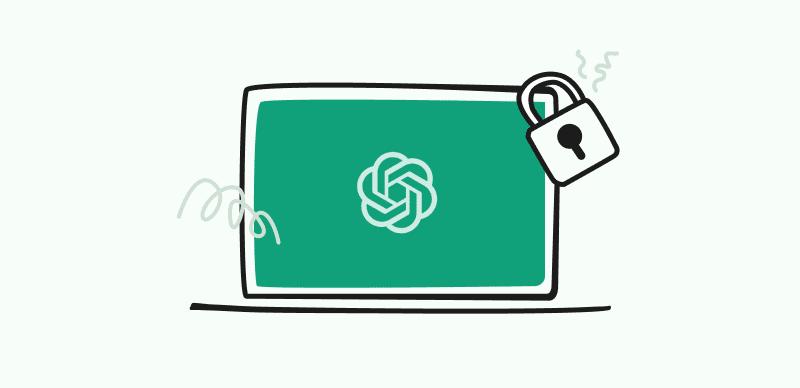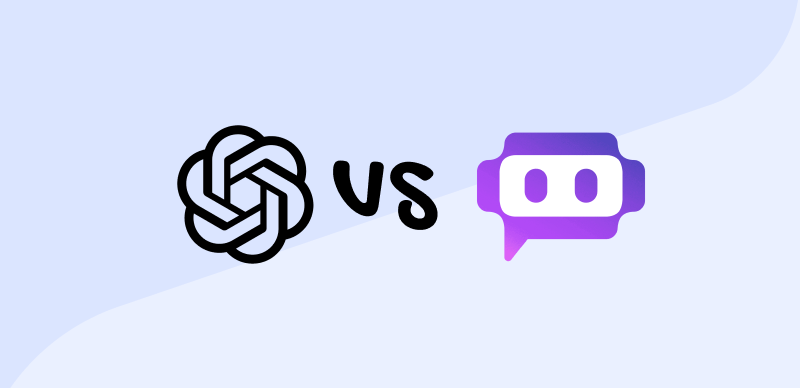
Poe vs. ChatGPT
Software capable of conversing with humans in natural language is becoming immensely popular, both for their practical advantages and for sheer entertainment potential. Due to intense demand, major technology companies are racing to release their versions of AI chatbots that could compete in this emerging market.
ChatGPT is perhaps the best-known product of this kind, but it’s hardly the only one. Several ChatGPT alternatives appeared to the public at approximately the same time, including the Poe platform released by Quora. Since all of these products are brand new and offer similar types of service, it can be tricky for first-time users to understand which one of them is the most promising.
This article will try to educate the users about Large Language Models and point out major differences between top AI products of today such as Poe vs. ChatGPT.
What is ChatGPT?
The appeal of ChatGPT consists mostly of its incredible simplicity and apparent expertise in almost any field of knowledge. This is a chatbot based on machine learning technology that can maintain a conversation with a human while using grammatically correct sentences that show a high level of semantic understanding. The behavior of the bot can seem ‘intelligent’, although it’s important to know that as all other LLM’s it is a purely statistical device that analyzes latent connections between tokens (i.e. words or phrases).
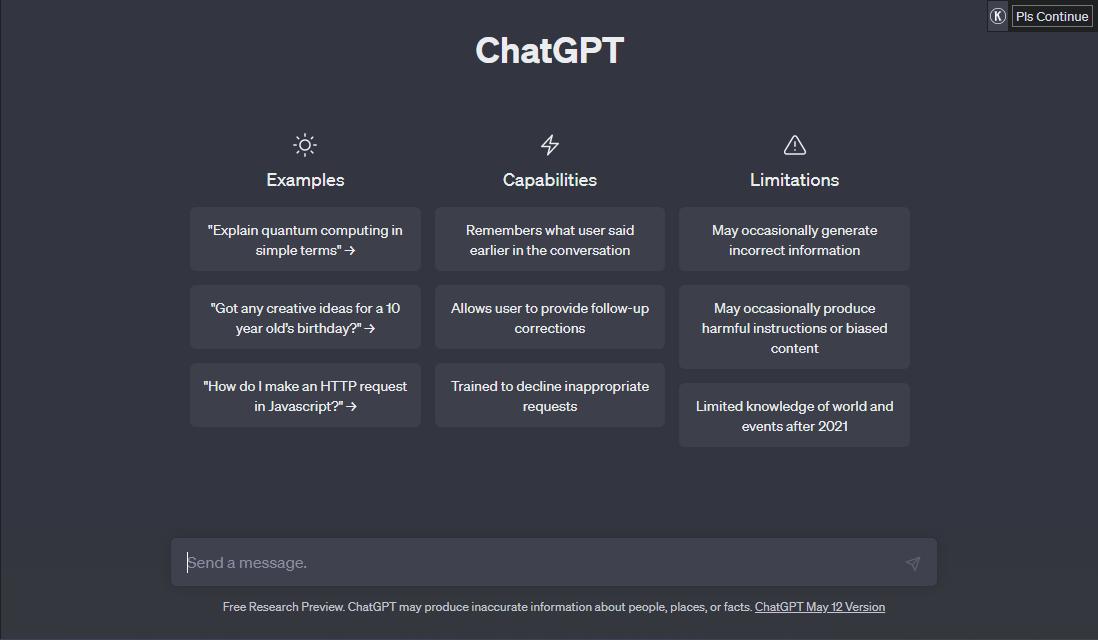
ChatGPT AI Chatbot Interface
As one of the first AI tools made available to the general public, ChatGPT instantly became a sensation when it was first released and quickly became one of the most visited locations on the whole internet. The reason for this is that the underlying GPT 3 model represents a huge improvement over previous iterations of generative AI software. This powerful model was trained on a huge number of samples, which empowers it to draw semantic conclusions about linguistic elements it hasn’t necessarily been exposed to. It reliably displays learning transfer features and performs well on tasks for which it hasn’t been specifically trained.
In terms of deployment, ChatGPT is hosted on the Open AI website and requires a valid account to use. It’s free for regular users, while those who want access to the latest deep learning model and guaranteed service during peak demand hours have the option to pay for ChatGPT Plus. Developers interested in the model can use the API to build new applications on top of it.
What is Poe?
This online service seems very similar to ChatGPT at first glance and is also based on deep learning algorithms, but Poe is more of an aggregate response-giving software than a stand-alone generative tool. Poe stands for Platform for Open Exploration, and it lets users search for answers from multiple AI-powered chatbots available on the web. It was developed by the popular online forum Quora, and it fits well into its concept of providing multiple answers to a wide range of questions.
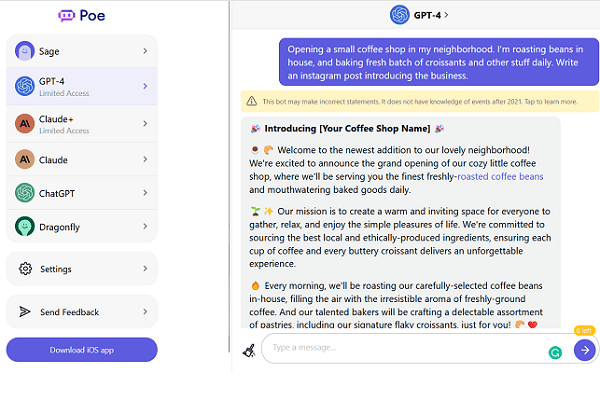
Poe itself is not AI-based, but it connects users with several generative AI applications, including ChatGPT, GPT 4, Dragonfly, Claude, and Claude +. This approach gives users the chance to directly compare the output of different AI tools and get meaningful answers from all of them. In this way, Poe acts as a neutral platform that doesn’t evaluate the quality of answers, and users can interact with each chat bot as they see fit. Switching from one chatbot to another requires just one click so it’s possible to search for the best answer in every situation.
Much like the chatbots themselves, Poe is an online platform that can be accessed from a web browser with a unique ID and password, although on iOS it works as a text messaging app. It first became available to the general public in early 2023 and is increasingly gaining new customers who see Poe as the gateway into the generative AI field. It represents a pioneering attempt to give users universal access to the latest generative AI applications and as such it has its place in the market.
ChatGPT vs. Poe – Main Differences
From a user perspective, using Poe may seem quite similar to direct interaction with AI chatbots such as ChatGPT. However, the platforms are not similar in a technical sense and in fact, Poe couldn’t function at all without true LLMs including ChatGPT feeding it information. That’s why it’s important to keep in mind that each of these products has its own advantages and disadvantages. Here is a summary of the main differences between Poe vs. ChatGPT:
- ChatGPT is an AI-powered chatbot that relies on its training to provide answers
- Poe combines answers from multiple chatbots, but doesn’t generate them on its own
- ChatGPT has much greater potential for integration with third-party products
- ChatGPT offers additional functionalities for premium users
- Poe doesn’t have the ability to become more refined through interaction with users
- Poe includes a way to cross-reference responses from one check bot with alternatives
- Poe is dependent on ChatGPT and other LLM’s to deliver core service
Also Read: ChatGPT Vs. Jasper- Which Is Better >
FAQs about Poe and ChatGPT
Is it possible to access the original ChatGPT through Poe’s web interface?
Yes, the standard ChatGPT that runs on GPT 3.5 model is one of the chatbots that can be reached through Poe. To do this, users need to open an account on Quora and log into Poe, then select ChatGPT as the preferred source of information in the left side panel. From here, you can simply interact with the chatbot in much the same way as if you accessed it from the Open AI website.
Are Poe and ChatGPT developed by the same software company?
No, these products were developed independently from one another. ChatGPT is a proprietary product owned by Open AI, while Poe is only using its API to deliver answers to users. In terms of ownership, Poe belongs to Quora, which originally developed it and currently maintains and operates it.
Is Poe more user-friendly than ChatGPT for new users?
Both software products are extremely simple to use, but new users who want to try out several chatbots might be better served to sign up for Poe than going to the individual websites for each product they would like to try. On the other hand, if you only want to use ChatGPT you shouldn’t be worried about the technical side or user interface.
Conclusion
As the digital ecosystem expands to accommodate new AI-based products, it’s logical that we are seeing derivative platforms that rely on existing AI tools to provide unique services. Poe is a great example of this approach, but despite being able to show ChatGPT answers it remains a separate platform. The distinction between Poe vs. ChatGPT may not seem hugely important to the average user, although it’s still beneficial to understand the advantages and disadvantages of each tool and choose the one that best fits the intended style of interaction.


